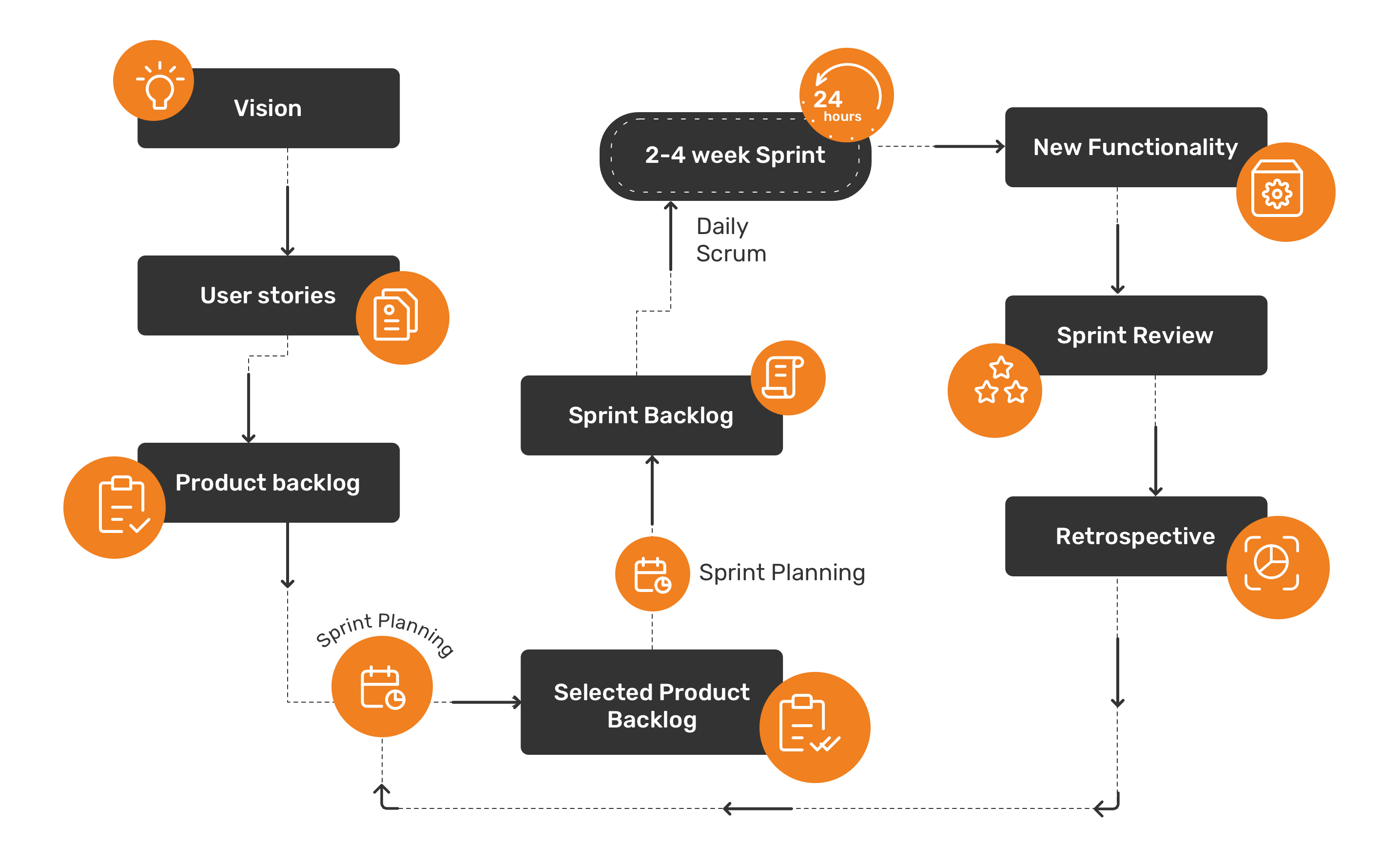Cloud Software Development Life Cycle in Ardas
Сloud Development Life Cycle (CDLC) is a process consisting of specific stages that begins when a decision is made to create software and ends when developers stop supporting software. Cloud service development requires a different approach than the traditional software development lifecycle (SDLC) as the cloud provider becomes a critical success factor of the overall project.
This approach allows to:
- Visualize a complex development process;
- Manage a project;
- Predict and plan delivery of work products throughout the development process;
- Manage over-budget/overshoot risks;
- Quickly determine at what stage the development is at the moment.
In this article, we will consider the main stages of the SaaS development life cycle and Ardas' processes that allow minimizing risks of SaaS development.
How CDLC Differs from SDLC
While SDLC was a way to introduce cost-efficiency while meeting business needs, in some cases, the complete opposite resulted. Companies using on-site infrastructure deployments experience update cycles that can take years with an overall low software performance as output. The lifecycle of cloud software development and deployment is a completely different story. CDLC is quicker and more adaptable to the ebb and flow of enterprise requirements.
CDLC also introduces a new paradigm of internet-based, scalable and distributed services. NIST provides an excellent definition that will help readers to understand better: “Cloud computing is a model for enabling ubiquitous, convenient, on-demand network access to a shared pool of configurable computing resources (e.g., networks, servers, storage, applications, and services) that can be rapidly provisioned and released with minimal management effort or service provider interaction.”
The main difference between the stages in the SDLC and CDLC lies in the development and launch stages.
Software Development Methodologies Used in Ardas
Selecting the right software development methodology for your SaaS product lifecycle depends mainly on your team size, goals, and other factors. Here is an overview of the most widely utilized and recognized software development methodologies that we use for our different projects.
Agile Development Methodology
Teams use the agile development methodology to minimize risks (such as bugs, cost overruns, and changing requirements) when adding new functionality. In all agile methods, teams develop the software in iterations that contain mini-increments of the new functionality. The agile development method has many different forms, including scrum, crystal, extreme programming (XP), and feature-driven development (FDD).

- Pros: The primary benefit of agile software development is that it allows the software to be released in iterations. Iterative releases improve efficiency by allowing teams to find and fix defects and align expectations early on. They also allow users to realize software benefits earlier, with frequent incremental improvements.
- Cons: Agile development methods rely on real-time communication, so new users often lack the documentation they need to get up to speed. They require a huge time commitment from users and are labor-intensive because developers must fully complete each feature within each iteration for user approval.
Dedicated development teams, managers, and companies accustomed to the waterfall method (see below) may have difficulty adjusting to an agile SDLC. So a hybrid approach often works well for them.

Learn more...
Do you want to learn more about Agile methodology? Check our article about Agile development advantages and disadvantages in software development.
DevOps Deployment Methodology
DevOps is a development methodology and a set of practices that support organizational culture. DevOps deployment centers on organizational change that enhances collaboration between the departments responsible for different development life cycle segments, such as development, quality assurance, and operations.

- Pros: DevOps is focused on improving time to market, lowering the failure rate of new releases, shortening the lead time between fixes, and minimizing disruption while maximizing reliability. To achieve this, DevOps organizations aim to automate continuous deployment to ensure everything happens smoothly and reliably. Companies that use DevOps methods benefit by significantly reducing time to market and improving customer satisfaction, product quality, and employee productivity and efficiency.
- Cons: Even in light of its benefits, there are a few drawbacks to DevOps:
- Some customers don’t want continuous updates to their systems.
- Some industries have regulations that require extensive testing before a project can move to the operations phase.
- If different departments use different environments, undetected issues can slip into production.
- Some quality attributes require human interaction, which slows down the delivery pipeline.

Don't Have DevOps for Your Project?
Discover all possibilities of DevOps consulting services by Ardas.
Waterfall Development Method
Many consider the waterfall to be the most traditional software development method that is usually used when you need to launch something fast and easy. The waterfall method is a rigid linear model that consists of sequential phases (requirements, design, implementation, verification, maintenance) focusing on distinct goals. Each phase must be 100% complete before the next phase can start. There’s usually no process for going back to modify the project or direction.

- Pros: The linear nature of the waterfall development method makes it easy to understand and manage. Projects with clear objectives and stable requirements can best use the waterfall method. Less experienced project managers, project teams, and teams whose composition changes frequently, may benefit the most from using the waterfall development methodology.
- Cons: The waterfall development method is often slow and costly due to its rigid structure and tight controls. These drawbacks can lead waterfall method users to explore other software development methodologies.
All the above software development methodologies are the most pervasive in software development. Each one has its own strengths and weaknesses and works effectively in different situations. When choosing your development methodology, consider combining each method's elements that work best for your team and your current project. In this way, you can create a hybrid development methodology that’ll get you to production securely and efficiently. Also, you can discuss your doubts with our team and we can suggest the best solution for you.
Cloud SDLC Phases With Examples
During development, before moving from the current stage to the next, it is necessary to complete each of its steps, for which they should be better understood. In this regard, the first three stages try to answer the test questions, and the last three are optimized to achieve actual results.
Let's take a closer look at each stage and analyze the results, some of which you may want to optimize for your specific situation.
SaaS Lifecycle Negotiations
This is how your project gets born. At this stage, all the paperwork takes place that will legally protect your intellectual property. Therefore, first of all, we will sign a non-disclosure agreement (NDA).
Further at this stage, we will arrange our first calls and discussions, during which we will find out your vision of the SaaS product, decide on the set of technologies, and offer a team of specialists with the necessary skills.
We always study the stack of technologies and come prepared for any issues that might appear on the way.

After that, Ardas will prepare an individual proposal that will take into account all of the above, and in addition to this, the timing and budget of the project. If the conditions are suitable for both parties, we sign the contract and move on to the next phase.
I am always there for the client during the first calls to ensure a smooth process. My 18 years of SaaS project development experience taught me to notice pitfalls before they come.

System Analysis

During this phase, you decide exactly what you want to do and what problems to solve:
- Identifying problems, goals and resources (such as personnel and costs);
- Exploring the possibilities of alternative solutions through meetings with customers, suppliers, consultants and employees;
- Learning how to make your product better than the competition.
After analyzing this data, you will have three options: develop a new system, improve the existing one, or leave it as it is.
During this stage, three specialists are involved in the work:
- Business Analyst: Competitive Analysis, Niche Analysis, Customer Profile, Customer Journey, Roadmap.
- Architect: Сreation of a technological architectural solution and a selection of technologies.
- Designer: UI / UX product sketches.
It is necessary to define and document the requirements of the end-user of the system - what are their expectations and how to fulfill them. In addition, a feasibility study is made for the project, which clarifies whether the project is organizationally, economically, socially, and technologically feasible. Maintaining good communication with customers is essential to ensure you have a clear vision of the end product and its functions.
The correct architecture of the project will allow using modern, proven technologies and distributing the load on the servers, which will increase performance and comply with all regulatory requirements (GDPR, HIPAA, etc.)

System Design
The design phase begins after a good understanding of the customer's requirements has been achieved. This phase defines the system elements, components, security level, modules, architecture, various interfaces and data types that the system operates on. The overall design of a system can be done in pen on a piece of paper - it defines how the system will look and function. Then an extended, detailed design is made, taking into account all functional and technical requirements, both logically and physically.
We conduct user research to identify the potential audience's needs and turn the product into user-friendly.

At this stage, you will be working with:
- Business Analyst: Responsible for the project portfolio, roadmap, functional and non-functional requirements. Creating a scope of tasks for the development team.
- Designer: has to create a design from the documentation.
- Architect: Creation of software documentation and DevOps design documentation.
- Development team: preparing for development, getting tech. knowledge from the architect, creating a testing strategy, checking those. documentation, project setup for all necessary development environments and interfaces.
SaaS Development
At this stage, your main contact person will be the project manager, who will describe in detail the tasks for the developers, communicate with the client and be the connecting element between the client and the team. This specialist also oversees the scrum sprints, the time and results of the project.
This phase follows a complete understanding of the system requirements and specifications. This is the actual process of developing a system, when the design of the system is already fully completed and visual. In the system development life cycle, this is where the code is written, and if the system includes the hardware part, the implementation phase will include the configuration and tuning of the hardware for specific requirements and functions.
At this stage, the system is ready for installation at the customer's site, for launch in combat mode. End-users may need training to become familiar with the system and know how to use it. The implementation phase can be very long, depending on the system's complexity.
Each created function goes through 2 stages - implementation and testing.
Ready To Build Your Project?
Book a meeting with our business delivery manager to get a free consultation about your SaaS.
Deployment and Testing
This is where various components and subsystems are assembled into one coherent system. We feed the system various inputs and analyze the output, behavior, and functioning. Testing is becoming more and more important for customer satisfaction, while it does not require knowledge of coding, hardware configuration, or design.
Our projects are always covered by tests to ensure that we met all our client's expectations and did even more than promised.

Testing can be performed by real users or a dedicated team of employees, or it can be systematic and automated to ensure that the system's actual results are consistent with the intended and desired ones.
From the experts at this stage, you will need DevOps who will be responsible for testing and stabilizing the product in the deployment environment.
System Support
During this phase, periodic technical support of the system is carried out to ensure that the system is not out of date. This includes replacing old equipment and continually evaluating performance. It also updates certain components to ensure that the system meets the necessary standards and the latest technologies to avoid exposure to current security threats.
Project development is only a small part of software creation. Literate support and a roadmap of the project will allow you to win the hearts of your customers and raise a new unicorn in your niche.

These are the six main stages of the system development life cycle, and it is an iterative process for each project. It is important to note that excellent communication with the customer must be maintained. Prototypes are crucial and useful for implementing requirements.
By building the system in short iterations, we can ensure that customer requirements are met before we build the whole system. Many system development lifecycle models are based on the idea of saving effort, money and time while minimizing the risk of non-compliance with customer requirements by the end of the project. Some of these models are the “iterative model” and the “agile model”.
How We Make Customer Lifecycle on SaaS for Project Development Completely Transparent
Ardas can guide your project through all stages - from the implementation of the idea to full-scale development, UX / UI design, testing and QA, as well as integration with third-party systems.
We developed and polished a long-term cooperation practice based on three cooperation models: startup phase, growth phase, and dedicated team. We shift from one model to another when this becomes good for the business thus providing you with the highest quality always and optimal processes and costs to implement the bravest SaaS ideas.
Now you know that building software isn't just about writing code. This process includes a lot of preparatory work (analysis, requirements creation) and additional work (testing, deployment), and the most important stage is support.
All the above information will allow you to confidently control your project and know what is hidden behind each stage. However, if you are looking for a dedicated development team to which you can confidently delegate all stages of the SaaS development process, Ardas is ready to take this headache off you. Fill out the contact form below to discuss your ideas!
